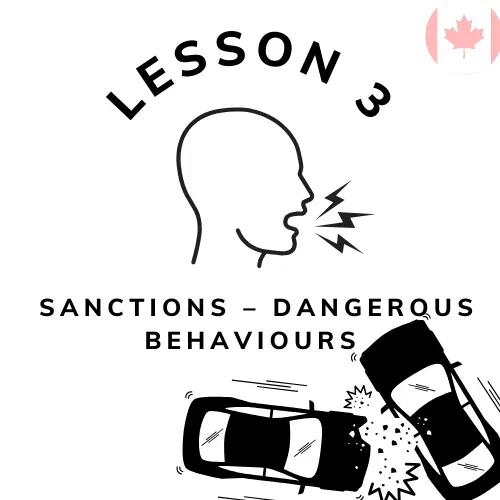Canada implemented sanctions to target actions that were dangerous to the public’s safety. The article examines various unsafe driving behaviors in Canada. It also discusses sanctions that are in place in order to discourage such behavior and their broader impact on improving road safety.
Common dangerous behaviors
1. Speeding: Excessive speeds are a major problem on Canadian roadways, and they contribute to many accidents. Speeding beyond the posted limit or driving too fast can have severe consequences. These include loss of control and increased stopping distances.
2. Distracted driving is the use of an electronic device while driving. This includes texting and talking on the telephone. The use of electronic devices while driving, such as texting or talking on the phone is a common form of distracted driving.
3. Aggressive driving: Aggressive behavior, such as tailgating and aggressive lane changing, can lead to tensions and dangerous situations on the roads.
4. Driving under the Influence is a very serious crime that can pose serious risks for both the driver as well as other road users. Impaired driving may result in impaired judgement, decreased coordination and an increased risk of accident.
Sanctions against Dangerous Behaviours
1. Speeding:
The severity of the offense determines the amount of fines. Fines are usually higher for zones and speeds with lower limits.
Demerit Points – Convictions of speeding result in an accumulation of points against the driving record. A high number of points may result in a suspension of your license.
License suspensions: A repeat offense of speeding or other egregious violation may result in a temporary or permanent suspension.
2. Distracted Driving:
The penalties for repeated violations of distracted driving are increasing.
Demerit Points: Accumulations of demerit for driving while distracted can lead to license suspension.
License suspensions may be imposed on repeat offenders, or anyone who causes accidents because they are distracted.
3. Aggressive Driving:
Fines: Monetary penalties are applied for driving offences that involve aggressive behavior, such as tailgating and aggressive lane changing.
For aggressive driving, demerit point accumulation can result in suspension of your license.
Driver Education Programs: Some jurisdictions require aggressive driving education for those convicted.
4. Driving Under the Influence of Alcohol (DUI):
Criminal charges: Driving while under the influence is a crime. A conviction can result in imprisonment, hefty fines and a criminal history.
License suspensions: DUI offenders are subject to immediate license suspensions. The duration varies depending on the blood alcohol content (BAC) and any previous DUI convictions.
Illumination Interlock Programs: In certain cases, DUI offenders may have to install ignition interlock units in their cars, which will prevent them from driving when alcohol is detected.
The implications of road safety are much wider.
1. Public Awareness and Education
Public education and awareness campaigns are vital in combating dangerous behavior. These campaigns are designed to change behavior by educating the public on the dangers of distracted driving, speeding and DUI.
2. Technology and enforcement:
Integration of technology such as red-light and speed cameras enhances the enforcement effort. Automated systems detect speeding violations and red light violations and can penalize them. They act as deterrents and complement traditional law enforcement.
3. **Community Policing:**
Initiatives for community policing aim to create positive relations between the police and local communities. Engagement with the local community and specific concerns about road safety helps to build trust and encourage responsible driving.
4. Graduated License Programs:
Graduated licensing is designed to help novice drivers adjust to the driving responsibilities. The programs usually include nighttime restrictions, limitations on passengers, and zero-tolerance for alcohol. They are designed to address dangerous driving behaviors in new drivers.
What are the challenges and considerations?
1. Enforcement Consistency:
It is difficult to ensure that sanctions are consistently enforced for dangerous behaviors. The effectiveness of the measures can be affected by variations in penalties and enforcement.
2. Technological Advancements:
The rapid development of technology brings both challenges and possibilities. The use of smartphones and other technology can distract drivers, even though advanced safety features may mitigate certain risks. It is important to strike a balance between the impact of technological advances on driving behaviour and those that are able to mitigate them.
3. Addressing the Underlying Factors
The root causes of dangerous driving behavior are usually underlying issues such as road congestion or stress. To address these issues, comprehensive strategies are needed that move beyond punitive actions to improve road safety.
Policies Recommendations
1. Standardized Enforcement Practices:
Standardizing enforcement procedures ensures that sanctions are applied consistently to drivers who display dangerous driving behavior. It may be necessary to create guidelines that law enforcement can follow, and encourage collaboration among jurisdictions.
2. Comprehensive Education Programs:
It is important to invest in comprehensive educational programs that address the causes of harmful behaviors. They can be tailored to specific groups, and raise awareness of the dangers associated with distracted driving, aggressive driving, speeding, or impaired driving.
3. Technology Integration:
The continued integration of technology into enforcement efforts will enhance the effectiveness and efficiency of sanctions. Utilizing advancements in artificial intelligence and data analytics, automated systems and other technologies can enhance monitoring and enforcement abilities.
4. Community Engagement:
Initiatives for community engagement should include collaboration among law enforcement, communities and stakeholders. Communication channels that are open can help identify specific concerns about road safety and allow interventions tailored to local needs.

Conclusion:
To address dangerous driving behaviors in Canada, a multifaceted approach is needed that includes effective sanctions, community involvement, technology advancements and public awareness. Implementing a consistent enforcement strategy, along with comprehensive educational programs, will be crucial to creating a culture that promotes responsible driving. While Canada refines its road safety policy, it should focus on collaboration, technology and the factors that contribute to unsafe behaviors. The goal of these initiatives is to make roads safer for all and reduce accidents caused by speeding, aggressive driving, distracted driving and impaired driving.
